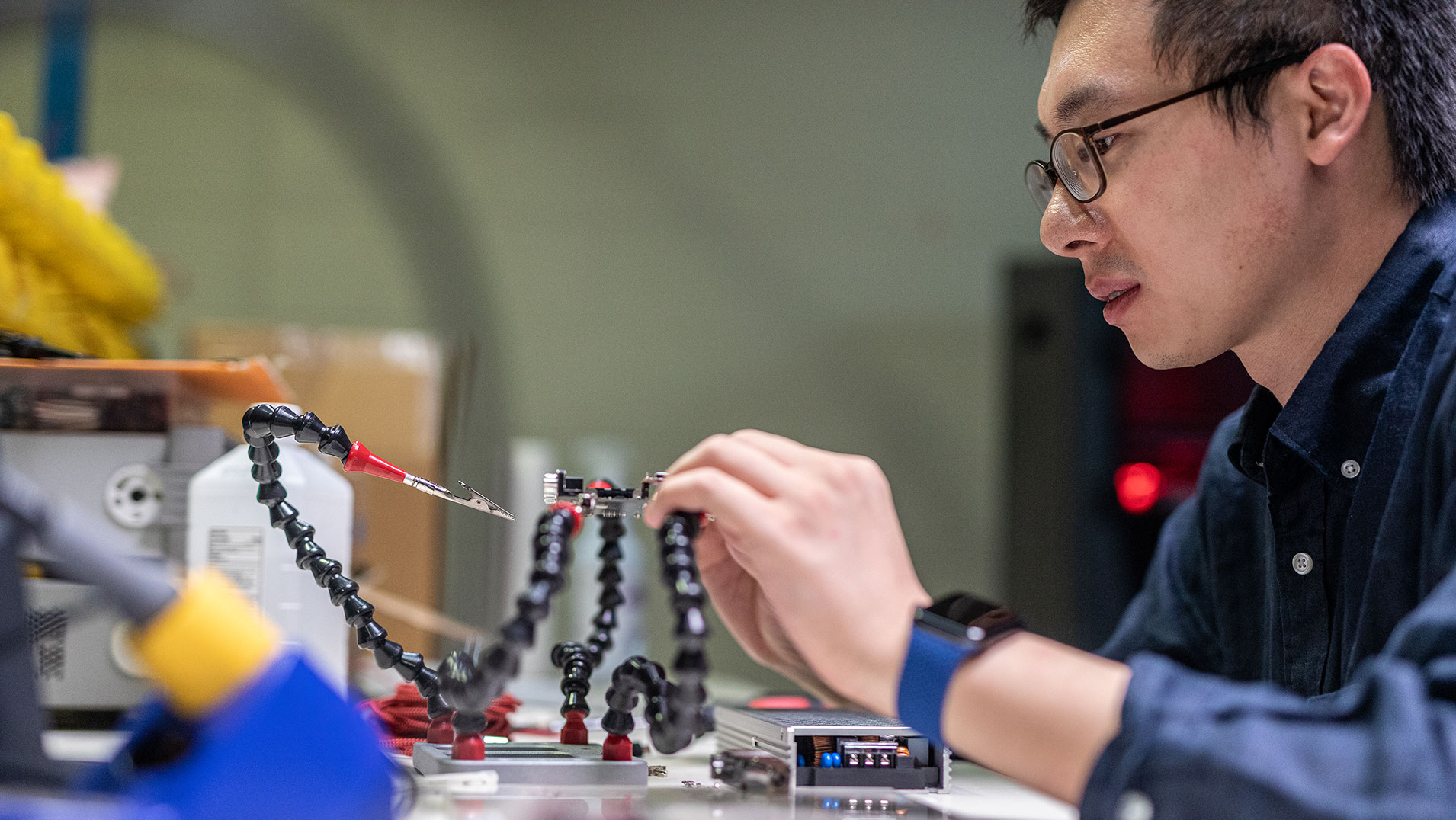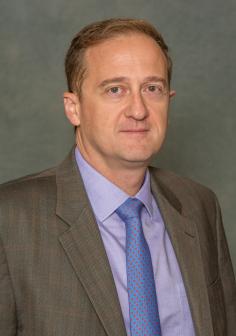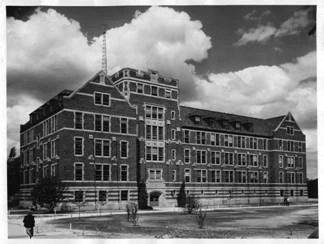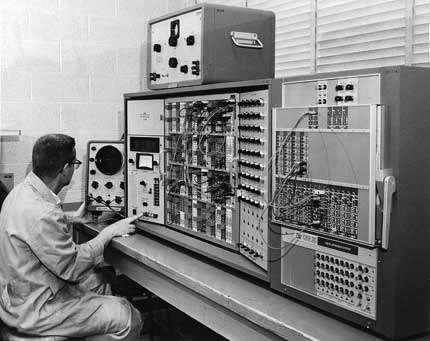
Welcome to Electrical and Computer Engineering
The Department of Electrical and Computer Engineering (ECE) has a tradition of excellence in teaching and research that dates to 1909. An ECE degree prepares electrical and computer engineers for a dynamic, ever-changing field and offers an excellent background in medicine, law, business, and other analytical disciplines. Our faculty are actively engaged in electromagnetics, materials and devices, microelectronics, computing, robotics and control, energy and power systems, signal processing and communications.
Students master their interests through classroom instruction, laboratory research, industrial internship experiences, international exchange programs, and project teaming. Design and hands-on labs and courses broaden their educational experience. ECE also has expanded research expertise in nanoscale technologies, advanced microsystems, ubiquitous communications, biological and biomedical engineering, signal processing, autonomous vehicles and robotics, and efficient energy production, transmission, and conversion.
863
Undergraduate students
(Fall 2023)
204
Graduate students
(Fall 2023)
172
Degrees granted
(2022-2023)
$16M
Research Expenditure
(Fall 2023)
39
Tenure Faculty
(Fall 2023)
The Department of Electrical and Computer Engineering offers the following undergraduate degree programs:
Bachelor of Science (B.S.) Computer Engineering
Bachelor of Science (B.S.) Electrical Engineering
The electrical engineering and computer engineering programs are accredited by the Engineering Accreditation Commission of ABET, http://www.abet.org/.

Visit Undergraduate Admissions for information on applying to the programs.

Welcome to the Department of Electrical and Computer Engineering (ECE) at Michigan State University. I hope you find this website both informative and filled with a sense of pride for the Department and its long tradition of excellence in teaching and research that has made it one of the premier programs in electrical and computer engineering.
Electrical and computer engineers are part of a dynamic and ever changing field. Technological advances in the past ten years have been astonishing and the future workforce shows a critical need for electrical and computer engineers to help advance such areas as nanoscale technologies, advanced microsystems, ubiquitous communications, biological and biomedical engineering, signal processing, autonomous vehicles and robotics, and efficient energy production, transmission and conversion. An ECE degree also offers an excellent background for advanced training in medicine, law, business, and other analytical disciplines. With an eye to the future and the challenges and excitement it holds, we strive at MSU to continually improve program quality - in classroom instruction, laboratory research, industrial internship experiences, international exchange programs, and project teaming.
Our Department has accredited B.S. degree programs in both Electrical Engineering and Computer Engineering. The current enrollment is approximately 300 full-time graduate students and 848 undergraduate students. Our students acquire a solid foundation in electrical and computer engineering theory. They gain experience in critical thinking and explore new and innovative ways to address advanced engineering problems. Design and hands-on labs and courses are offered in all years of the curriculum. The undergraduate capstone class engages students in teaming and open-ended problem solving. As a result, our students learn how to work with people from other science or engineering fields and are prepared for true-to-life work environments. In fact, over the past few years the department has put a strong emphasis on all the undergraduate students having opportunities for engineering experience outside the classroom by participating in cooperative education, internships, education abroad, and/or undergraduate research. Surveys of graduating seniors show that more than 90 percent have had some type of engineering experience outside the classroom.
The ECE graduate program is built on the quality of our 45 faculty and their research. Our research activities have witnessed strong growth in recent years with annual research expenditures now around $15M. Our faculty members are leaders in their chosen field and are highly respected by their peers and we have 14 IEEE Fellows, 14 NSF CAREER awardees, three DARPA YFA awardees, one AFOSR Young Investigator awardee, and four University Distinguished Faculty in the department. While the ECE faculty are continually investigating in new areas of research, our focus remains on Computer Engineering (computer architecture, computer networks, and VLSI/microelectronics), Electrosciences (electromagnetics, electronic materials and devices, and nondestructive evaluation), and Systems (biomedical engineering, control and robotics, power electronics and systems, and signal processing and communications).
Please take time to look through our website or visit us in person to see the possibilities available in a growing, research-centered, student-oriented department. These are exciting times and we do want to share our enthusiasm with you. Please do not hesitate to contact us if you have any questions.
John Papapolymerou
Chairperson and MSU Foundation Professor
The Department of Electrical and Computer Engineering offers the following undergraduate degree programs:
Master of Science (M.S.) Electrical and Computer Engineering
Master of Science (M.S.) Electrical and Computer Engineering - online
Doctor of Philosophy (Ph.D.) Electrical and Computer Engineering
- James R. Anderson - Executive Manager, Electric Asset Management, Consumers Energy
- Gerald Dejean - Researcher (senior level) – Microsoft Research, Microsoft Corporation
- Brian Kent - Chief Scientist, Applied Research Associates, Inc.
- Charles Macon - Senior Electronics Engineer, Air Force Research Laboratory
- Steve McLaughlin - Dean and Southern Company Chair, College of Engineering, Georgia Institute of Technology
- Seyed Hossein Mousavinezhad - Professor and Chair, Department of Electrical Engineering, College of Engineering, Idaho State University
- Karen Newman - Vice President, Global Partner, IBM Global Business Services
- John Papapolymerou - Michigan State University
- Mark Roberts - Senior Electronics Engineer. Air Force Research Laboratory
- Betty Shanahan - Associate Vice President, Administration and Operations, DePaul University
Mission
The mission is to provide undergraduate and graduate education that is characterized by quality, access, and relevance; and to develop distinctive research programs in electro science, systems and computer engineering, each with the promise of sustained excellence as measured in scholarship, external investment, reputation, and impact.History
 Electrical engineering became a formal part of Michigan Agricultural College (MAC) in 1909 when the Division of Engineering was established. The new division had four units, including physics and electrical engineering. In 1916, the electrical engineering department was established separate from physics. For a period of time, it was named Electrical Engineering and Systems Science. In 1947 the Electrical Engineering building was built, (now know as the Computer Center) and housed MSU's first mainframe computer, the MISTIC. In 1998, the department changed its name to Electrical and Computer Engineering.
Electrical engineering became a formal part of Michigan Agricultural College (MAC) in 1909 when the Division of Engineering was established. The new division had four units, including physics and electrical engineering. In 1916, the electrical engineering department was established separate from physics. For a period of time, it was named Electrical Engineering and Systems Science. In 1947 the Electrical Engineering building was built, (now know as the Computer Center) and housed MSU's first mainframe computer, the MISTIC. In 1998, the department changed its name to Electrical and Computer Engineering.
Timeline

1893: First course in electrical engineering, offered under the Department of Physics
1901: Department of Physics and Electrical Engineering established
1907: A new Engineering Building was built, featuring over 40 labs and lecture rooms.
1915: Department of Electrical Engineering separated from the Physics Department
1917: R.E. Olds gifted $100,000 to rebuild the new (Olds Hall of) Engineering building
1947: Electrical Engineering Building established, (now known as the Computer Center)
1969: Department renamed Department of Electrical Engineering and Systems Science
1962: A new Engineering Building was constructed on Shaw Lane
1988: Name changes to Department of Electrical Engineering
1989: Engineering was renovated and ECE moved to the current location (2120)
1998: Department becomes the Department of Electrical and Computer Engineering
2000: NSF Engineering Research Center (a partnership with MSU, U of M, and MTU) for Wireless Integrated MicroSystems (WIMS) established
2002: Fraunhofer Center for Coatings and Laser Applications established
2005: Zhuzhou Electric Locomotive Research Institute and Michigan State University Power Electronics Systems Center (ZELRI-MSU) established
2005: High Performance Computer Center (HPCC) established
2006: ECE Chairperson, Satish Udpa, becomes Dean for the College of Engineering
2006: Elias Strangas and Fang Zheng Peng received funding from the 21st Century Jobs Fund Award from the State of Michigan
2007: Timothy Grotjohn becomes ECE Chairperson
2010: NSF-founded BEACON Center for the Study of Evolution established
2014: Leo Kempel, ECE Faculty, becomes Dean for the College of Engineering
2015: John Papapolymerou becomes ECE Chairperson
Department Chairs

1901-1904 - Martin D. Atkins (physics and electrical engineering)
1904-1916 - Arthur Rodney Sawyer (physics and electrical engineering)
1916-1924 - Arthur R. Sawyer (electrical engineering)
1924-1947 - L.S. Foltz
1947-1957 - Ira B. Baccus
1957-1965 - Lawrence Von Tersch
1965-1968 - Harry G. Hedges, acting (Class photo - first row, 4th from left)
1968-1976 - Herman E. Koenig
1976-1987 - John B. Kreer
1987-1989 - Harriett Rigas
1989-2000 - Jes Asmussen, Jr.
2000-2001 - Diane Rover, acting
2001-2005 - Satish Udpa
2005-2007 - Timothy Grotjohn, acting
2007-2014 - Timothy Grotjohn
2014-2015 - Timothy Hogan, acting
2015-Pres. - John Papapolymero
Mission
The mission is to provide undergraduate and graduate education that is characterized by quality, access, and relevance; and to develop distinctive research programs in electro science, systems and computer engineering, each with the promise of sustained excellence as measured in scholarship, external investment, reputation, and impact.History
 Electrical engineering became a formal part of Michigan Agricultural College (MAC) in 1909 when the Division of Engineering was established. The new division had four units, including physics and electrical engineering. In 1916, the electrical engineering department was established separate from physics. For a period of time, it was named Electrical Engineering and Systems Science. In 1947 the Electrical Engineering building was built, (now know as the Computer Center) and housed MSU's first mainframe computer, the MISTIC. In 1998, the department changed its name to Electrical and Computer Engineering.
Electrical engineering became a formal part of Michigan Agricultural College (MAC) in 1909 when the Division of Engineering was established. The new division had four units, including physics and electrical engineering. In 1916, the electrical engineering department was established separate from physics. For a period of time, it was named Electrical Engineering and Systems Science. In 1947 the Electrical Engineering building was built, (now know as the Computer Center) and housed MSU's first mainframe computer, the MISTIC. In 1998, the department changed its name to Electrical and Computer Engineering.
Timeline

1893: First course in electrical engineering, offered under the Department of Physics
1901: Department of Physics and Electrical Engineering established
1907: A new Engineering Building was built, featuring over 40 labs and lecture rooms.
1915: Department of Electrical Engineering separated from the Physics Department
1917: R.E. Olds gifted $100,000 to rebuild the new (Olds Hall of) Engineering building
1947: Electrical Engineering Building established, (now known as the Computer Center)
1969: Department renamed Department of Electrical Engineering and Systems Science
1962: A new Engineering Building was constructed on Shaw Lane
1988: Name changes to Department of Electrical Engineering
1989: Engineering was renovated and ECE moved to the current location (2120)
1998: Department becomes the Department of Electrical and Computer Engineering
2000: NSF Engineering Research Center (a partnership with MSU, U of M, and MTU) for Wireless Integrated MicroSystems (WIMS) established
2002: Fraunhofer Center for Coatings and Laser Applications established
2005: Zhuzhou Electric Locomotive Research Institute and Michigan State University Power Electronics Systems Center (ZELRI-MSU) established
2005: High Performance Computer Center (HPCC) established
2006: ECE Chairperson, Satish Udpa, becomes Dean for the College of Engineering
2006: Elias Strangas and Fang Zheng Peng received funding from the 21st Century Jobs Fund Award from the State of Michigan
2007: Timothy Grotjohn becomes ECE Chairperson
2010: NSF-founded BEACON Center for the Study of Evolution established
2014: Leo Kempel, ECE Faculty, becomes Dean for the College of Engineering
2015: John Papapolymerou becomes ECE Chairperson
Department Chairs

1901-1904 - Martin D. Atkins (physics and electrical engineering)
1904-1916 - Arthur Rodney Sawyer (physics and electrical engineering)
1916-1924 - Arthur R. Sawyer (electrical engineering)
1924-1947 - L.S. Foltz
1947-1957 - Ira B. Baccus
1957-1965 - Lawrence Von Tersch
1965-1968 - Harry G. Hedges, acting (Class photo - first row, 4th from left)
1968-1976 - Herman E. Koenig
1976-1987 - John B. Kreer
1987-1989 - Harriett Rigas
1989-2000 - Jes Asmussen, Jr.
2000-2001 - Diane Rover, acting
2001-2005 - Satish Udpa
2005-2007 - Timothy Grotjohn, acting
2007-2014 - Timothy Grotjohn
2014-2015 - Timothy Hogan, acting
2015-Pres. - John Papapolymero